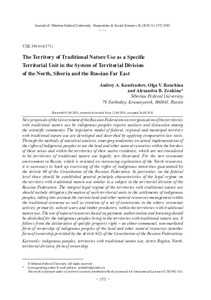Показать сокращенную информацию
The Territory of Traditional Nature Use as a Specific Territorial Unit in the System of Territorial Division of the North, Siberia and the Russian Far East
| Автор | Kondrashev, Andrey A. | en |
| Автор | Ronzhina, Olga V. | en |
| Автор | Zenkina, Alexandra B. | en |
| Автор | Кондрашев, А.А. | ru_RU |
| Автор | Роньжина, О.В. | ru_RU |
| Автор | Зенкина, А.Б. | ru_RU |
| Дата внесения | 2018-10-28T04:06:47Z | |
| Дата, когда ресурс стал доступен | 2018-10-28T04:06:47Z | |
| Дата публикации | 2018-10 | |
| URI (для ссылок/цитирований) | https://elib.sfu-kras.ru/handle/2311/90262 | |
| Аннотация | New proposals of the Government of the Russian Federation on reorganisation of the territories with traditional nature use by indigenous peoples require analysis and discussion among the scientific community. The legislative model of federal, regional and municipal territory with traditional nature use are developed and described by applying comparative law tools. Through the methods of statistical analysis, emerging tendencies on actual implementation of the rights of indigenous peoples to use the land and other natural resources within the borders of these areas and within the territories of their native residence, which are not considered to be territories of traditional nature use legally, are illustrated. For the new economic environment in Russia, which is oriented on increasing exploration of the North resources, it is necessary to back up exercising of the rights of indigenous minorities guaranteed by the Article 69 of the Constitution of the Russian Federation. In particular, on the federal level there should be established general principle characteristics of the legal regime on the territory with traditional nature use similar to a subject in the territorial division of the Russian Federation. The integral legal regime of the territories with traditional nature use should include obligatory formation of such territorial units in the settlements of indigenous peoples, taking into account the current land and other natural resources management within the traditional economy as well as creation of a set of constraints in the others’ economic activity, primarily, subsoil users and timber producers, within the territories with traditional nature use. The use of natural resources based on payment, authorization and licensing should be abolished for the indigenous peoples living in the territories with traditional nature use. It follows from the declaration of specific property right – an ethno-communal, non-marketed form of ownership of indigenous peoples of the land and other natural resources (another form of ownership provided by the Article 9(2) of the Constitution of the Russian Federation) | en |
| Аннотация | Новые проекты Правительства Российской Федерации по реорганизации территорий традиционного природопользования коренных малочисленных народов становятся предметом анализа и дискуссий в научном сообществе. При помощи сравнительных методов, используемых в области права, рассматривается правовая модель федеральной, региональной и муниципальной территорий традиционного природопользования. Применяя методы статистического анализа, авторы раскрывают современные тенденции в фактической реализации прав коренных нардов на использование земли и других природных ресурсов в этих зонах и на тех территориях их коренного проживания, которые официально не признаны территориями традиционного природопользования. Учитывая современную экономическую обстановку в России, нацеленную на увеличение добычи ресурсов Севера, необходимо поддерживать реализацию прав коренных меньшинств, гарантированных статьей 69 Конституции Российской Федерации. В частности, говоря о федеральном уровне, необходимо определить общие базовые характеристики правового режима территории традиционного природопользования, подобно режиму административного субъекта Российской Федерации. Комплексный правовой режим упомянутых территорий должен подразумевать обязательное формирование территориальных единиц в поселениях коренных народов с учетом системы земле- и природопользования, принятой в рамках традиционной экономики, наряду с ужесточением правил для экономической деятельности других исполнителей, прежде всего разработчиков недр и производителей древесины, на территориях традиционного природопользования. В декларации о правах на отдельные виды собственности закрепляется этнообщинная, нерыночная форма собственности на землю и другие природные ресурсы для коренных народов (другая форма собственности прописана в статье 9(2) Конституции Российской Федерации). | ru_RU |
| Язык | en | en |
| Издатель | Сибирский федеральный университет. Siberian Federal University | en |
| Тема | indigenous peoples | en |
| Тема | territories with traditional nature use | en |
| Тема | Arctic Region | en |
| Тема | North | en |
| Тема | territorial division | en |
| Тема | form of ownership | en |
| Тема | коренные народы | ru_RU |
| Тема | территории традиционного природопользования | ru_RU |
| Тема | Арктический регион | ru_RU |
| Тема | территориальное деление | ru_RU |
| Тема | форма собственности | ru_RU |
| Название | The Territory of Traditional Nature Use as a Specific Territorial Unit in the System of Territorial Division of the North, Siberia and the Russian Far East | en |
| Альтернативное название | Территория традиционного природопользования как отдельная территориальная единица в системе территориального деления Севера, Сибири и Дальнего Востока России | ru_RU |
| Тип | Journal Article | en |
| Контакты автора | Kondrashev, Andrey A.: Siberian Federal University 79 Svobodny, Krasnoyarsk, 660041, Russia | en |
| Контакты автора | Ronzhina, Olga V.: Siberian Federal University 79 Svobodny, Krasnoyarsk, 660041, Russia | en |
| Контакты автора | Zenkina, Alexandra B.: Siberian Federal University 79 Svobodny, Krasnoyarsk, 660041, Russia; sashalitv@yandex.ru | en |
| Контакты автора | Кондрашев, А.А.: Сибирский федеральный университет Россия, 660041, Красноярск, пр. Свободный, 79 | ru_RU |
| Контакты автора | Роньжина, О.В.: Сибирский федеральный университет Россия, 660041, Красноярск, пр. Свободный, 79 | ru_RU |
| Контакты автора | Зенкина, А.Б.: Сибирский федеральный университет Россия, 660041, Красноярск, пр. Свободный, 79 | ru_RU |
| Страницы | 1572-1592 | ru_RU |
| Журнал | Журнал Сибирского федерального университета. Гуманитарные науки. Journal of Siberian Federal University. Humanities & Social Sciences;2018 11 (10) | en |

